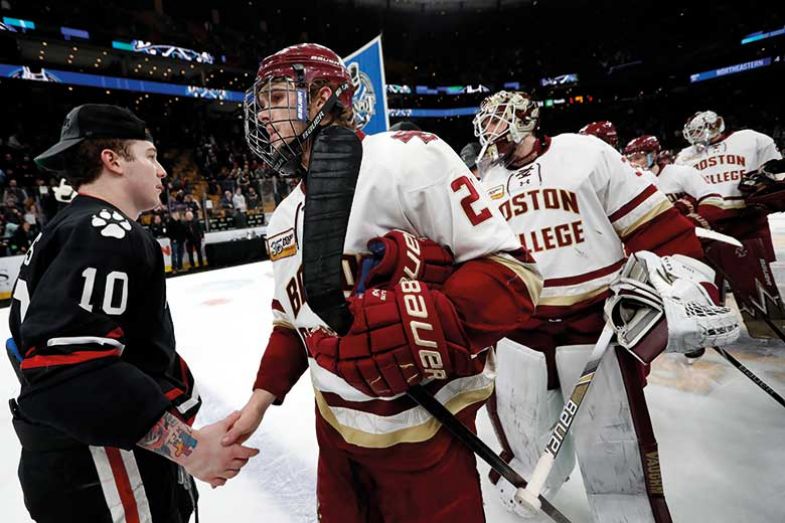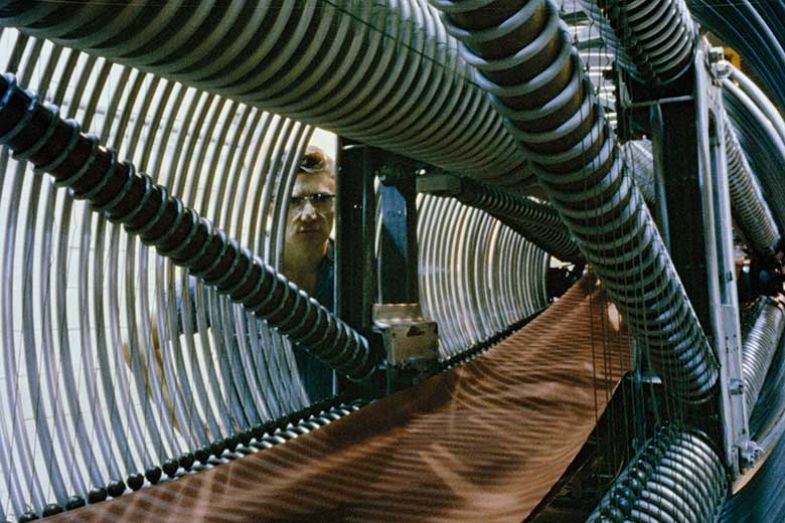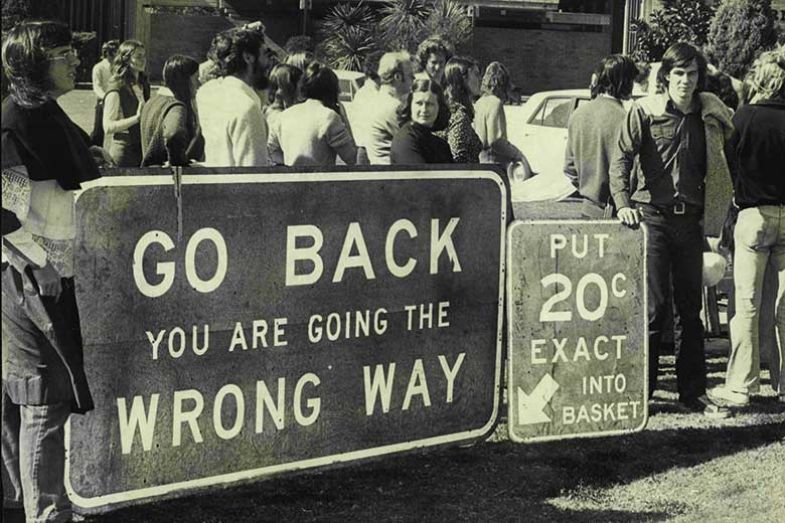It’s almost two hours into the game at what is reputedly the world’s oldest ice hockey arena, but raucous student fans show no signs of quietening down. As the overtime clock in Northeastern University’s game against Boston University begins, hundreds of Northeastern Huskies fans high up in the cheap seats launch into yet another singalong to a blaring pop track. Many diehards also ignore the 4,666-seat Matthews Arena’s chilly temperature and remove their shirts.
Even in a city as sports-mad as Boston, Northeastern’s passionate ice hockey fans are widely recognised for the boisterous support they offer – despite the team’s less than spectacular record of success. The match against their rivals from a different branch of the city’s green subway line is just one of hundreds of fiercely fought sporting fixtures between the Boston area’s universities each year. The “big four”, in sporting terms, of Northeastern, Boston University, Boston College and Harvard University also regularly face off in basketball, soccer, baseball, lacrosse, rowing and American football, often in both men’s and women’s competitions. The University of Massachusetts, Amherst, Brandeis University, Tufts University and others add to the glut of fixtures attended by the metropolitan area’s estimated 250,000 students, alumni and other older sports enthusiasts.
But tribal sporting loyalties do not stop fans from socialising with students from the other institutions, says Cameron Bracco, a first-year computer science student at Northeastern. “We all go to each other’s parties – it’s hard not to interact with other universities’ students in a town like Boston.”
The social buzz generated by these clashes is just one of the benefits of having a high number of universities located in the same town. Some argue that proximity also aids research, since near-neighbours can collaborate more easily. Others claim that large employers in need of top young talent are making multimillion-dollar calls on investing in big student towns. But how significant are these supposed benefits for universities themselves – particularly the less prestigious ones? And is there a sense in which sharing a city with a more prestigious neighbour makes it harder for an institution to move out of its shadows, to promulgate a distinct identity and assert its own value?

Animal magnetism: the Northeastern University Huskies and Boston College Eagles are big draws
There are more than 50 higher education institutions in the greater Boston area, of which seven are inside the top 250 of the Times Higher Education World University Rankings. Yet some academics at those institutions feel that the proximity of the mighty Massachusetts Institute of Technology and Harvard – 4th and 6th respectively in THE ’s latest rankings – makes it harder for them to communicate their work.
“We will sometimes have some brilliant research and stories that local and national media totally ignore,” a senior medical professor at Boston University tells THE. “When we ask why, they’ll often just say: ‘We cover the Longwood Medical Arena [home to Harvard Medical School and its associated hospitals] and we don’t have enough people to cover other areas.’ ”
Competing with the slick PR operations of Harvard and MIT is tough in other respects, says another Boston University professor, again speaking on condition of anonymity. “Boston University is much more engaged with the city than other universities [in Boston are], but I’m not sure it gets enough credit for it,” he explains, referencing his institution’s community work and links to local businesses. “The existence of Harvard and MIT often means that many big players in Boston’s commercial world gravitate towards them as the ‘obvious universities’.”
Name-recognition can also be an issue for those operating in university towns, admits Philip Altbach, founding director of Boston College’s Center for International Higher Education. In Boston College’s case, the similarity of its name to that of Boston University can be problematic for those outside the state. “We are not a college and we’re not in Boston, so it is quite confusing,” he says, referring to the university’s location in the suburban city of Newton, six miles west of downtown Boston.
On the other hand, those within Massachusetts can also fail to acknowledge how renowned many of the universities within their vicinity have become. “Four of Boston’s universities have changed from being quite local institutions to [being] national and international-facing research universities. Boston College used to be the place where Irish and working-class students went if they didn’t get into Harvard – now it’s become hugely successful in its own right,” Altbach says, pointing out that just 27 per cent of 31,000 applicants were accepted last year. “Boston College graduates are central to the finance industry and rated as some of the best in the country,” he adds.
Having worked at many universities across the US, Altbach perceives some advantages to being the “only game in town” in higher education. For instance, the University of Wisconsin-Madison is both “an academic and sporting giant”, he says: “All the attention and loyalty in Wisconsin is focused on it.” Similarly, the local community around the University at Buffalo, at the western fringe of New York state, is similarly united around its flagship institution in a way that multi-institution towns are not, he adds.
Overall, however, Altbach sees Boston’s cluster of universities as overwhelmingly positive for each of them. The city’s booming biotech industry, which employs about 35,000 people, is one conspicuous example of how the concentration of superb researchers, university graduates and research-engaged hospitals translates into success for both institutions and the city more generally, he says. Last year, Boston, which has almost 1,000 employers in the field, overtook California as the US’ number one biotech hotspot, after a decade of steady expansion. The sector’s workers earn far more than most professors do, with the average wage standing at almost $139,000 (£106,000).
“Biotech is largely driven by MIT and Harvard, but Tufts and Boston University also benefit, and Boston College to some degree,” Altbach says, referring to increased opportunities for collaboration and student internships.
The panoply of cranes around Kendall subway station, at the more corporate end of MIT’s sprawling campus in Cambridge, is testament to the huge levels of private investment pouring into the city. In 2016, venture capitalists ploughed almost $3 billion into biopharma in Massachusetts alone, but wider technology firms, large and small, are also setting up in the area, enhancing what Martin Schmidt, MIT’s provost, calls “a very strong ecosystem” in the area. “Companies from all over the country want to come here because it has the density [of universities and graduates] that you need to be successful,” he explains. Google and Twitter have created a presence near MIT, as has Boeing, which will use its 100,000 square feet of lab space to develop autonomous planes.
This influx of high-tech employers is good news for the local community, providing high-skilled support roles and taxes for civic services; MIT paid $56 million in local commercial property taxes from its rental activities, making it Cambridge’s biggest single taxpayer despite its tax-exempt status.

Joint effort: only by collaborating can universities afford facilities such as the Argonne lab
Boston’s status as an education city also helps to attract more scholarly students to its lesser lights, many argue. Boston University’s own academic pedigree is impressive: it is where Alexander Graham Bell developed the telephone and where numerous Nobel laureates have worked; its latest graduate to make a big impact is Alexandria Ocasio-Cortez, the high-profile 29-year-old recently elected to represent the Bronx in the House of Representatives. But current student Mercedes Munoz admits that Boston’s overall academic reputation was an important factor in drawing her 2,000 miles from her native Texas to study psychology. “I grew up in a mainly immigrant community – it was a bilingual place, where the local paper could be read by a sixth-grader,” she explains. “I wanted to go somewhere for university which was ‘academic’: where everyone in the city was held to, or aspired to, a higher standard – somewhere which would push me to do better.”
Meanwhile, Ciana Cronin, a second-year business administration student at Northeastern and a native of Arizona, welcomes the opportunity to attend lectures at other Boston institutions; her course, for instance, involves music business modules taken at the nearby Boston Conservatory at Berklee.
Parents can also feel more comfortable sending their students to a university town, observes Richard Miller, president of Olin College of Engineering, a small, highly selective college in Needham, 11 miles west of Boston: “If you’re asking parents to send their children hundreds of miles away, they want to know they are safe, in an environment that knows how to look after students,” he says.
For academics, Boston’s potential to solve academia’s “two-body problem” of finding work for academic couples is a big draw, Miller says. Studies suggest that at least one-third of US faculty have partners who are also academics – rising above 50 per cent for academic scientists. Yet dual career opportunities are often limited; Miller used to be a dean at the University of Iowa, whose staff and students represent around half of the 75,000 people living in Iowa City. “It is a superb research university, but the big problem is that there is no other employer in town. We used to say that it took 10 minutes to recruit a faculty member and three months to recruit the spouse,” he says.
This familiar scenario means that, except in the rare event that two posts at the same institution arise simultaneously, the “trailing spouse ends up compromising” and leaving academia. According to Miller, this “often means you have people who are overqualified working in jobs they don’t enjoy” – but not in Boston. Olin and other institutions use their informal connections in the city to find roles for their new hires’ partners.
Olin also benefits from the occasional desire of high-flying researchers at the larger Boston universities for a change of scene, Miller adds: “I was recently contacted by a [locally living] immunologist at Harvard, with her own National Institutes of Health grants, who said that her husband had taken a job at [nearby] Babson College and she was fed up of doing her daily commute [into Boston]. We hadn’t really thought how we’d accommodate an immunologist, but it’s opened up some really interesting areas of research for us.”
Olin, which was founded in 1997 with a $460 million endowment, has even managed to peel off some would-be MIT students seeking a more hands-on learning experience, says Miller. “Our entire leadership are MIT grads, so we know the place and love it, but it hasn’t always been the most welcoming environment for women,” he notes. Chloe Grubb, a fourth-year Olin student from New Mexico, was one of those to turn down an MIT offer. “I’d always wanted to go to MIT, but when I looked into its undergraduate programme it didn’t feel right,” she tells THE.
Another potential benefit of situating universities in close proximity to each other is the opportunity it affords for close collaboration on research projects. For instance, in the US Midwest, staff from three research-intensives from the Chicago area – Northwestern University, the University of Chicago and the University of Illinois at Chicago – work with colleagues from Wisconsin-Madison (just 150 miles away) at the Argonne National Laboratory, a multidisciplinary science and engineering centre outside Chicago founded in the 1940s to carry out Enrico Fermi’s work on nuclear reactors for the Manhattan Project and now run by the University of Chicago for the US Department of Energy.
“No university on its own could afford the infrastructure at Argonne – it’s just massive,” explains Chicago’s president Robert Zimmer. “Our staff also benefit from working with people from other institutions – Illinois at Chicago is, for instance, one of the world’s great engineering universities. These partnerships are increasingly important because the problems that scientists are dealing with are increasingly complex and require large-scale collaboration.”
In Boston, the Tufts Clinical and Translational Science Institute is another such example, winning a $56 million NIH grant to support work at hospitals affiliated with Brandeis, MIT and Northeastern, as well as Tufts. “Each institution has its own personality and quite different areas of distinction, so it is this combination of talents which is important,” says Tufts provost Deborah Kochevar.
But research collaborations of this sort are infrequent, observes MIT’s Schmidt. Aside from the Broad Institute, a joint MIT-Harvard medical research centre, there is little in terms of large-scale partnerships, he says: “Research is pretty competitive, so it’s difficult when faculty [at different universities] are working in the same space to tell them to play together.”
Nor does proximity to large research-intensives necessarily confer much tangible benefit to UK universities – in research terms, at least. For instance, analysis by Alex Hulkes, strategic lead for the Economic and Social Research Council’s insights team, found that institutions within the so-called Golden Triangle of London, Oxford and Cambridge – most of which are in the capital itself – do not have unexpectedly high success rates when applying for research council grants. In fact, the universities of Durham, Lancaster and York were the stand-out performers in the four years up to 2016-17.
“The data suggest that ‘only show in town’ institutions do indeed punch their weight – and in some cases punch above it,” observes Graeme Reid, professor of science and research policy at UCL. “It suggests to me that different places and institutions have distinctive strengths and the best ones play to these strengths.”

Far from a poor imitation: Queensland University of Technology developed its own strength and distinct positioning
Staff at “only show in town” institutions might also be spared pangs of jealousy regarding their older, richer neighbours’ more central locations, more expensive facilities or more academically able students. But few lecturers, it seems, will admit to coveting life at a more prestigious institution. For instance, asked whether he would prefer to work at the more famous National University of Singapore, Scott Anthony, assistant professor of history at Singapore’s Nanyang Technological University, denies that the thought has ever crossed his mind.
“To me, it would be like saying to someone in a start-up: ‘Wouldn’t you rather work for IBM?’ ” he says. “In some ways, it would be like asking people at Imperial, the Institute of Education or [Central] St Martins whether they were jealous of Oxbridge. I suppose it’s possible, but that might suggest they were in the wrong place anyway.”
This sense of working at an institution with a distinct, alternative identity, rather than a poor imitation of a more prestigious neighbour, is crucial, according to Peter Coaldrake, who led the Queensland University of Technology (QUT) between 2003 and 2017. QUT gained its university status in 1989, some 80 years after Brisbane neighbour and Group of Eight member the University of Queensland. “We always accorded the University of Queensland great respect, as we did [nearby] Griffith University, but we focused on developing our own strengths and distinct positioning,” explains Coaldrake, citing QUT’s tagline of “a university for the real world”. “The local Queensland student market came to understand that a QUT degree in business, for example, was quite different to a commerce degree from UQ. They liked what we did and what we stood for.”
Another example of QUT’s more business-facing approach was its establishment of the world’s first creative industries faculty at the same time as it abolished its arts faculty. “For others, this might have seemed crazy-brave, but, for us, this was a straightforward decision,” Coaldrake says. “Our two local competitors were covering the so-called arts disciplines perfectly well, and we saw fairly early the potential of the creative economy and embraced these disciplines and emerging fields.”
The physical renewal of QUT’s various campuses was also deliberately distinctive, with an emphasis on creating great spaces for students. “We sought not to compete with the Gothic towers or expansive quadrangles of older and more established universities, here or elsewhere,” Coaldrake reflects. “To do so would have been a ticket to nowhere. In a sense, we managed to stay under the radar for quite a long time, but then started to really come out of the shadows.”
Moving with the times: loosening university hierarchies

U turn: people were disdainful of Adam Graycar’s choice of UNSW Sydney
A long time ago, when I was 17, I decided to go to university. Living in Sydney, I chose the University of New South Wales (now UNSW Sydney). It was a very young institution at the time, having only been established in 1949, but I went there because it offered subjects that the University of Sydney did not.
The universities that bear the names of the cities of Sydney, Melbourne and Adelaide enjoyed about 100 years as the only universities in town. Trams had “the university” as a destination. Sure, there were other tertiary institutions – often technology- or even trade-based – but these weren’t places a toff would ever consider.
So people were very disdainful about my choice. They said to me: “Don’t go to UNSW: nobody will ever recognise a degree from there.” But both UNSW and Melbourne’s Monash University subsequently became formidable institutions, and, today, are part of the elite Group of Eight.
Meanwhile, my current state’s newest university, the University of South Australia, outperforms the neighbouring University of Adelaide – with which it came close to merging last year – on some metrics. Politicians in South Australia try to sell education as an important state commodity, but it used to irritate me to hear them continually asserting that we have three world-class universities in our town (the other being Flinders University). What we have are three universities that provide a good education for their students and have some world-leading research and some mediocre research. This is the norm. Even in my former division at the Australian National University, where I was a dean, there was one very highly productive group – and a very long tail of modest research performers.
Still, the ratio of pockets of research excellence to pockets of sloth varies, and hierarchies are a reality. One of the tragedies of modern university life is that rankings-obsessed vice-chancellors try to turn their universities into world-leading research-intensives even though the raw material they are working with will never get them there. This creates a lot of pain along the way – as Flinders, with its various rounds of job cuts, has experienced recently.
Academics are as aware as the students are of the institutional pecking order. I was also a dean at Rutgers, the State University of New Jersey, and we never had applicants for our faculty positions from Ivy League universities. Their academics played in their own sandpit. We played in the state university sandpit. In the rest of New Jersey, there were at least a dozen or two other universities that nobody has ever heard of. They all played in their own sandpits, and very rarely did faculty cross boundaries. Faculty in those lesser-known universities had huge teaching loads and no expectations of doing research, but their students got reasonable jobs.
Many Harvard and MIT PhDs cannot get jobs at the university from which they graduated, but love the Boston lifestyle and, thus, stay in town, creating a rising research tide that raises all ships in the city. But that is possible only because Boston contains half a dozen research-intensives – so these people can stay in their sandpits without leaving the city.
The hierarchy is even more rigid in Australia, where there are old-boy networks (it is mostly boys) of doctors, lawyers and architects who would still never hire anybody from a “new” university. But then those people would never hire anyone who did not go to the right secondary school either. Hopefully those dinosaurs are dying out and that, in the new digital and professional age, skill will count for more than old school ties.
Perhaps that will also loosen university hierarchies and allow more movement of staff between institutions in university cities. That would make the institutional benefits of being located close to other universities considerably greater than they currently are.
Adam Graycar is professor of public policy at Flinders University, Adelaide.
后记
Print headline: Life in the shadows






